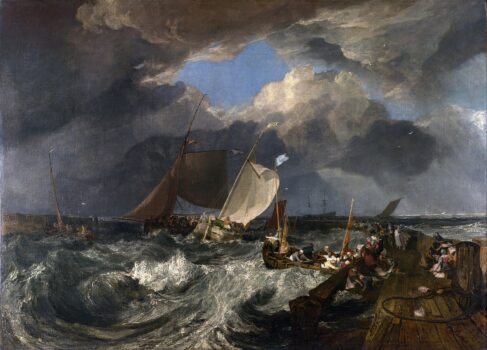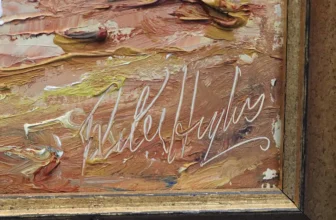Meaning of J.M.W. Turner’s “Calais Pier: An English Packet Arriving”
J.M.W. Turner, widely regarded as one of the most influential figures in the history of British art, is renowned for his expressive use of color, turbulent marine scenes, and a visionary sense of atmosphere that prefigured the Impressionists. One of his most powerful early marine works is “Calais Pier: An English Packet Arriving”, painted in 1803. This ambitious oil painting not only demonstrates Turner’s technical brilliance but also embodies complex themes of human struggle, nature’s sublime force, and political and nationalistic undertones reflective of his time.
What Is “Calais Pier: An English Packet Arriving” All About?
At its surface, “Calais Pier” depicts a tumultuous maritime scene: a stormy sea outside the French port of Calais where a mail packet boat, having just crossed the English Channel, is seen arriving in dangerous weather. A flurry of human activity unfolds as passengers disembark and sailors grapple with nature’s power, trying to secure the vessel against the chaos of the sea.
But beneath this narrative lies something more profound. The painting is not just a depiction of a ship’s arrival, it is a study of the eternal tension between man and nature, the fragility of human endeavor, and the volatile historical context of Anglo-French relations. It captures a moment of crossing, a literal journey between two nations, yet also a metaphor for transition, instability, and the ever-changing tides of life and history.
What Is Happening in the Painting?
The canvas erupts with motion. The sea is depicted in violent unrest, its gray-green waves crashing with white froth. The sky above is a mix of oppressive clouds, light breaking sporadically through in shafts that fall unevenly across the scene, signaling hope and danger in equal measure.
To the right, the English packet boat fights the waves, listing dangerously as it approaches the rickety wooden pier of Calais. Sailors shout and strain at ropes, while figures lean overboard, nauseous from the journey. Passengers, some collapsed, others upright, attempt to stabilize themselves or help others off the vessel.
On the left, the French pier juts out into the sea. Small groups of people await the packet’s arrival, their expressions unreadable from the distance but evocative of expectation, perhaps suspicion. The foreground is filled with churning water and floating debris, remnants of sea travel, perhaps symbolic of the detritus of human ambition.
The sense of movement is visceral: Turner uses angled lines, dramatic diagonals, and a palette of grays, browns, and pale greens to suggest chaos and urgency. The whole scene is alive, animated by the forces of wind, water, and human endeavor.
Artistic Techniques and Style
“Calais Pier” marks a crucial point in Turner’s career. Painted when he was just 28 years old, the piece reflects the influence of Dutch maritime painting, especially the works of Willem van de Velde and Ludolf Bakhuizen. However, Turner goes further. Unlike the crisp clarity of his Dutch predecessors, Turner embraces atmospheric uncertainty. He uses looser brushwork, muted colors, and diffused light to render a more psychological and emotional experience.
The work is Romantic in style, one of the clearest early examples of Turner embracing Romanticism’s emphasis on the sublime, the overwhelming power of nature, and individual emotional response. The depiction of the sea is not simply a background or setting, it becomes a character in itself, a living, violent force that dwarfs the humans it surrounds.
Turner was already interested in themes of transition, turbulence, and the sublime, and “Calais Pier” presents these with a new maturity. His treatment of light and shadow, the raw energy of the brushwork, and the dynamic composition all suggest that this painting was a personal statement as much as a public artwork.
Symbolism and Interpretation
1. The Sublime and Nature’s Power
At its heart, “Calais Pier” is a meditation on the sublime, a central concept in Romantic art and literature. Edmund Burke, a key figure in the development of the idea of the sublime, described it as the feeling evoked when humans confront something vast, terrifying, and beyond their control, such as storms, mountains, or the sea.
Here, Turner’s storm-tossed sea embodies this concept. The packet boat and the figures are dwarfed by the uncontrollable power of nature. The painting becomes a vivid representation of humanity’s vulnerability, our frailty in the face of forces that cannot be reasoned with or overcome by will alone.
2. National Identity and Tension
The painting was created in 1803, the very year that the fragile Peace of Amiens between Britain and France collapsed. War between the two nations was imminent once again. Turner’s depiction of Calais, located in France, just across the channel from England, is not just geographical. The packet boat crossing the channel becomes a symbolic bridge between two nations engaged in a complicated relationship defined by conflict, proximity, and cultural rivalry.
The English packet arriving in a hostile French harbor during a storm can be interpreted as a metaphor for England’s geopolitical position, braving the elements, persevering, but not without difficulty or danger. The precariousness of the arrival is perhaps symbolic of Britain’s own perceived identity during times of strife, resilient but embattled.
3. Human Endurance and Struggle
The figures in the painting are not idealized. They are seasick, disheveled, anonymous. Unlike traditional heroic maritime paintings that show noble sailors or triumphant naval scenes, Turner’s work demystifies the experience of sea travel. It is dangerous, physically exhausting, and deeply uncertain.
In this way, “Calais Pier” aligns with the Romantic ethos of valuing individual emotion and experience. The ordinary figures stand in for everyman, their journey not glorious but deeply human. Their struggle resonates with the viewer as a reflection of our own battles, internal, societal, and existential.
Type of Art: Romanticism Meets the Marine Tradition
“Calais Pier: An English Packet Arriving” belongs firmly within the tradition of Romantic landscape painting, but more specifically, it is a marine painting, a genre that Turner would become especially renowned for.
However, Turner’s approach transforms the genre. Where traditional marine art focused on naval victories, technical precision, and static beauty, Turner infuses it with emotion, danger, and drama. His work here is a hybrid, part documentary, part allegory, part psychological study.
Moreover, Turner innovates with perspective and light, using the sea and sky as expressive tools, not just backdrops. His influence can be seen in later artists such as Claude Monet and the Impressionists, who admired Turner’s atmospheric effects and painterly freedom.
Where Is “Calais Pier” Located Today?
“Calais Pier: An English Packet Arriving” is housed in the prestigious National Gallery in London, part of the United Kingdom’s public collection. It remains one of the Gallery’s important early 19th-century works and is frequently studied by art historians and admired by visitors for its dynamic composition and emotional depth.
As part of the National Gallery’s Turner collection, it offers viewers an opportunity to engage with the early evolution of a master who would go on to reshape the entire course of Western painting. The painting is often displayed alongside other works from Turner’s early period, providing context for his artistic development and thematic interests.
Reception and Legacy
At the time of its exhibition at the Royal Academy in 1803, “Calais Pier” received a mixed reception. Critics were impressed by its scale and ambition but were uncertain about its loose brushwork and emotional tone, both of which diverged from the accepted academic norms of the period. It was seen as overly dramatic, even unfinished by some.
However, with hindsight, it is clear that this work marked a turning point in Turner’s career. It heralded his full embrace of Romantic ideals and set the stage for later masterpieces such as “Snow Storm – Steam-Boat off a Harbour’s Mouth” (1842) and “The Slave Ship“ (1840), where the sea becomes even more abstract, violent, and expressive.
The legacy of “Calais Pier” lies in its pioneering spirit. It opened new pathways for landscape and marine painting, elevating emotion, atmosphere, and personal interpretation above literal representation. Its influence is echoed in the work of countless artists who followed Turner’s lead in embracing the power of suggestion, mood, and sublime beauty.
Why “Calais Pier” Still Matters
“Calais Pier: An English Packet Arriving” is more than just a stormy seascape. It is a manifesto of artistic daring, a vivid portrait of human vulnerability, and a political parable cloaked in the crashing surf. Turner invites the viewer not just to witness a scene, but to feel it, to experience the chill of sea spray, the instability of the deck, the tension of arrival.
In an age where much art was about ideals and control, Turner gave us instability and truth. He anticipated the anxieties of the modern world, alienation, uncertainty, the ever-present threat of chaos, and rendered them in paint with raw honesty and sublime power.
For all these reasons, “Calais Pier” endures not only as a pivotal work in Turner’s oeuvre but as a profound meditation on the human condition, bridging the divide between past and present, England and France, man and nature.




